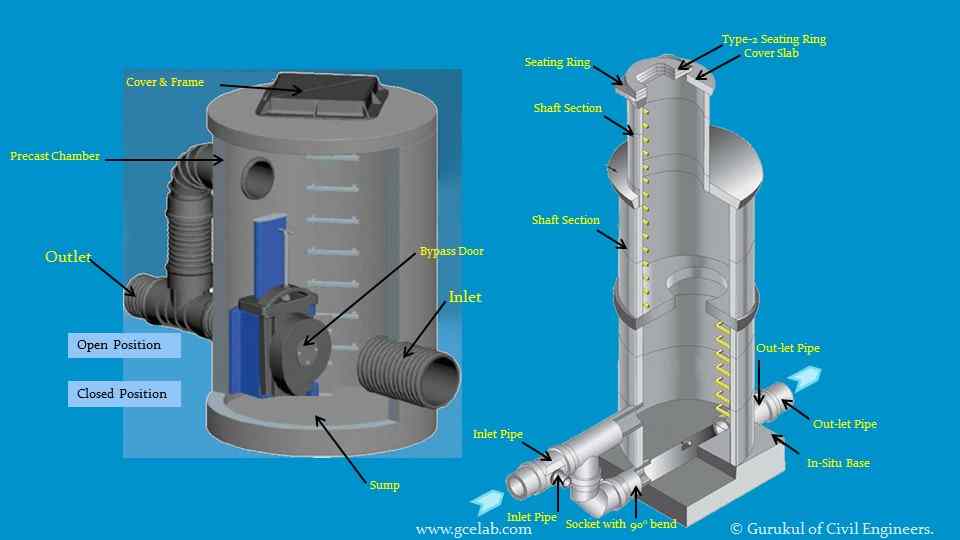What is Drainage Flow Control Device? 7 Important Points
- By
- Pooja |
- February 13, 2021 |
- Civil Engineering, Drainage Engineering,

Table of Contents
What is drainage flow control?
What are the different types of flow control?
What is Surface Water Attenuation?
What is the hydro-brake chamber?
What is drainage flow control?
When there is heavy rain, and underground drainage pipes are full to their capacity, it leads to flooding of the downstream pipe network and that leads to flooding of the sewer or watercourses.
Drainage flow control helps to regulate the rate of flow of surface water from upstream and prevent downstream pipe networks from flooding.
Along with its major advantage of flood control, there are many other benefits of flow control such as speed control of upstream surface water, self-cleansing, controlled discharge to the downstream and release of clean water to the environment.
How does flow control work?
To control the upstream surface water, flow control units are used. The unit can work as a standalone unit or work with the collective efforts of multiple units (also called a flow control system). The control systems are capable of attenuating water, velocity control, releasing water with controlled flow rates, and self-cleansing of water.
Lastly, it can be operated remotely from the control centre which is very useful during heavy rain times and minimise the requirement of site visits.
What are the different types of flow control?
The flow control system works right from the first step which is Attenuation. Please see the flowchart below to quickly understand the various stages of the flow control system.
What is Surface Water Attenuation?
In recent years, heavy rains, severe storms and flooding are noticed in various cities across the globe. The rapid urbanisation and significant increase of impermeable surfaces (due to physical infrastructure development) lead to generating flooding and damage to the infrastructure as well as livelihoods.
So, what is the solution?
There is no one-line answer to it, but multiple actions could prevent it from happening or minimise it to low severity levels. Surface water attenuation is one of the key actions to move in this direction. It simply means collecting the surface in a storage tank or crate or pipe and releasing it slowly at controlled rates.
Following are the key types of Attenuation systems:
- Attenuation Pond
- Large Size Attenuation Pipes
- Attenuation Crates
- Rainwater Diffusor
Attenuation Pond:
Attenuation Ponds are manmade natural ponds to collect the surface water of adjacent highways or motorways or large infrastructure spread in a wide area. An attenuation Pond is the most practical method to collect and treat surface water runoff.
It allows for both sedimentation and biological processes within the pond and as a result, much clearer water is discharged to the downstream network or the outfall.
The positioning and size of the pond are dependent on various parameters such as catchment area of the adjacent road, proximity to outfall such as river or stream, acceptable discharge, ground filtration rate (if acceptable), downstream network capacity, etc.
Large Size Attenuation Pipes:
Large size attenuation pipes deliver the same results as attenuation ponds except for ground filtration. These pipes are made of precast concrete or Plastic materials and come with high strength to withstand heavy vehicular loads.
Attenuation Crates:
Attenuation crates are interlocked crates to store water and release slowly to the ground through infiltration or discharge it to the downstream network and finally to the outfall points.
Rainwater Diffuser:
The rainwater diffuser collects surface water into the voided subsoil aggregate in a permeable or impermeable infiltration system. These diffusers are made of high-strength material to withstand heavy vehicular load and are very suitable for a car park, residential access or driveways, etc.
What is the hydro-brake chamber?
Hydro-brake controls and customises the flow of upstream water. There are no moving parts, and it runs without a power supply; as a result, it is a reliable and low-maintenance infrastructure to maintain surface water flow.
Hydro-brakes can be customised to suit the site and drainage catchment requirements. This means it can be installed for small to medium to large-scale drainage flow control systems.
What is HydoValve?
HydroValve is provided to control the water flow coming from the attenuation tank to a customised rate ranging from 1 litre per second to 50 litres per second. It discharged the water to the downstream network or watercourse.
What is outfall?
The term outfall is applied to the point where the road drainage system discharges into a different type of drainage system: There are three types of commonly used outfalls:
- Natural Channels.
- Watercourses
- Purpose-made Drainage Channels
I hope the blog gives you a detailed understanding of flow control devices and associated functioning to control surface water drainage systems and minimise the possibility of drainage flooding.
Please feel free to like, share and comment.
Admin, gcelab.com Please see our Pillar Post to know why we founded gcelab.com.
Read More:

Pooja
Founder at gcelab.com, Pooja is an Entrepreneur unlocking human potential. Working in the Principles of Lean Start-up, Pooja believes in Transparency and User Happiness the most. Pooja’s background in teaching gives her a sophisticated grasp on even the most tedious aspect of course building. She is passionate about people who believe that good is not enough.

